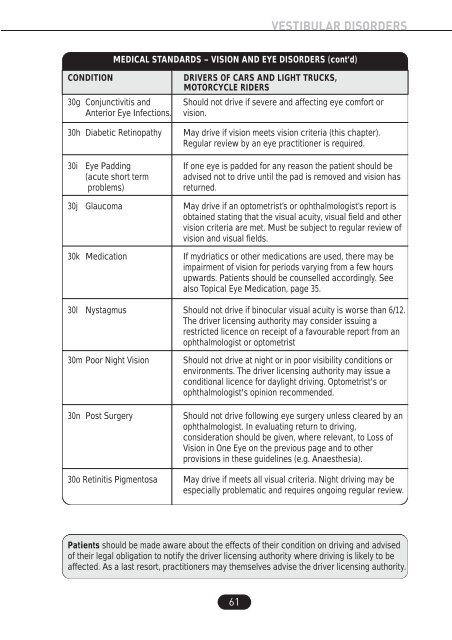Assessing Fitness to Drive - BiOptic Driving Network
Assessing Fitness to Drive - BiOptic Driving Network
Assessing Fitness to Drive - BiOptic Driving Network
- No tags were found...
You also want an ePaper? Increase the reach of your titles
YUMPU automatically turns print PDFs into web optimized ePapers that Google loves.
VESTIBULAR DISORDERSMEDICAL STANDARDS – VISION AND EYE DISORDERS (cont’d)CONDITION30g Conjunctivitis andAnterior Eye Infections.30h Diabetic Retinopathy30i Eye Padding(acute short termproblems)DRIVERS OF CARS AND LIGHT TRUCKS,MOTORCYCLE RIDERSShould not drive if severe and affecting eye comfort orvision.May drive if vision meets vision criteria (this chapter).Regular review by an eye practitioner is required.If one eye is padded for any reason the patient should beadvised not <strong>to</strong> drive until the pad is removed and vision hasreturned.30jGlaucomaMay drive if an op<strong>to</strong>metrist’s or ophthalmologist’s report isobtained stating that the visual acuity, visual field and othervision criteria are met. Must be subject <strong>to</strong> regular review ofvision and visual fields.30k Medication30l Nystagmus30m Poor Night Vision30n Post Surgery30o Retinitis Pigmen<strong>to</strong>saIf mydriatics or other medications are used, there may beimpairment of vision for periods varying from a few hoursupwards. Patients should be counselled accordingly. Seealso Topical Eye Medication, page 35.Should not drive if binocular visual acuity is worse than 6/12.The driver licensing authority may consider issuing arestricted licence on receipt of a favourable report from anophthalmologist or op<strong>to</strong>metristShould not drive at night or in poor visibility conditions orenvironments. The driver licensing authority may issue aconditional licence for daylight driving. Op<strong>to</strong>metrist's orophthalmologist's opinion recommended.Should not drive following eye surgery unless cleared by anophthalmologist. In evaluating return <strong>to</strong> driving,consideration should be given, where relevant, <strong>to</strong> Loss ofVision in One Eye on the previous page and <strong>to</strong> otherprovisions in these guidelines (e.g. Anaesthesia).May drive if meets all visual criteria. Night driving may beespecially problematic and requires ongoing regular review.Patients should be made aware about the effects of their condition on driving and advisedof their legal obligation <strong>to</strong> notify the driver licensing authority where driving is likely <strong>to</strong> beaffected. As a last resort, practitioners may themselves advise the driver licensing authority.61


